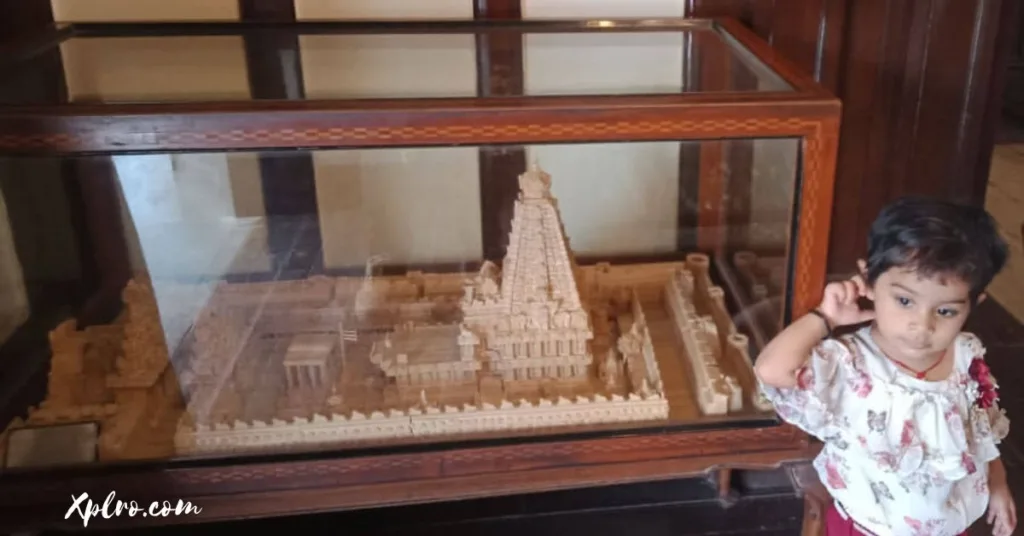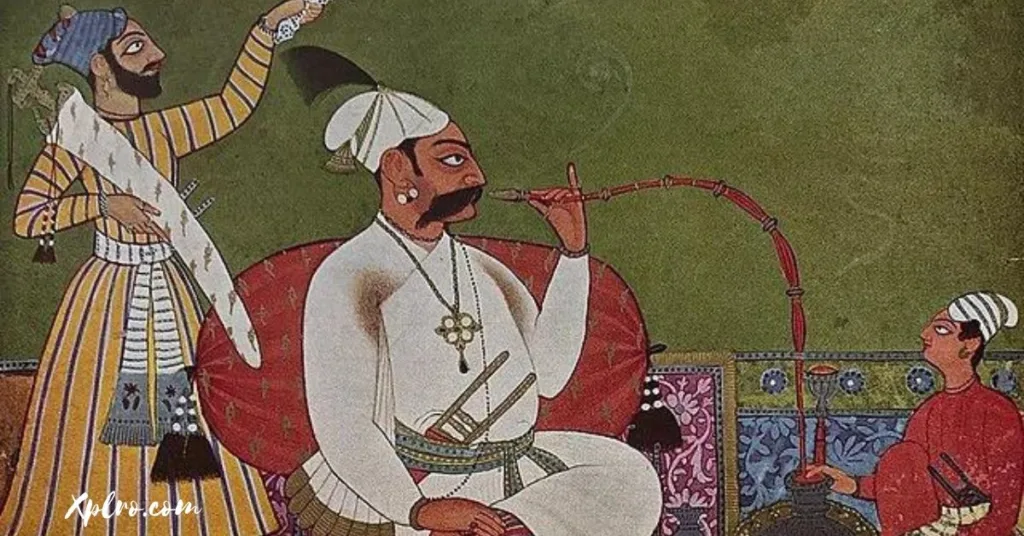Nestled amidst the scenic beauty of Jammu, Amar Mahal Palace is a testament to the grandeur and opulence of a bygone era. Once the home of the Dogra royal family, this magnificent palace now stands as a museum, offering visitors a fascinating peek into the region’s rich history and cultural heritage. Built in the 19th century, Amar Mahal showcases a stunning blend of French and Indian architectural styles. It’s not just a visual treat but also a treasure trove of art, culture, and royal artifacts. From its striking red sandstone facade to its sprawling gardens overlooking the Tawi River, every corner of Amar Mahal exudes a royal charm.
Step inside, and you’ll be transported back in time. Each room tells a story of royal grandeur and the artistic finesse of the period. The palace museum houses a captivating collection of miniature paintings, antique furniture, and even a 120-kg solid gold throne, giving you a unique glimpse into the lives of Jammu’s former royalty.
How to reach:
1. By Air: The nearest airport is Jammu Civil Enclave, about 8 kilometers away. It’s well-connected to major cities in India. From the airport, you can take a taxi or auto-rickshaw to Amar Mahal in about 20 minutes.
2. By Train: Jammu Tawi Railway Station is about 6 kilometers away. It’s well-connected to cities across India. Once there, you can find taxis, auto-rickshaws, or buses to Amar Mahal in about 15 minutes.
3. By Road: Jammu is well-connected by roads and highways. You can take buses or cars from nearby cities and states. JKSRTC and private operators run regular bus services. Once in Jammu, take a taxi, auto-rickshaw, or local bus to Amar Mahal. Hiring a private car is also a good option.
4. By Local Transport: In Jammu city, you can use taxis, auto-rickshaws, or buses to reach Amar Mahal. If you’re staying close by, walking or taking a short auto-rickshaw ride might be convenient.
Best time to visit:
1. Autumn (September to November): Autumn offers mild weather, perfect for exploring the palace without discomfort. Clear skies and cool breezes make it ideal for outdoor activities.
2. Winter (December to February): Winter is relatively mild in Jammu. It’s a great time for tourists who enjoy cooler temperatures. Mornings and evenings can be chilly, so pack warm clothing. The misty mornings create a mystical atmosphere.
3. Spring (March to April): Spring brings warmer weather and blooming gardens. It’s ideal for leisurely strolls and enjoying the vibrant landscapes.
4. Summer (May to August): Summer can be hot, with temperatures exceeding 35°C. It’s generally not recommended due to the heat. Additionally, monsoon rains (July to August) might disrupt travel plans.
Attractions:
Amar Mahal Museum:

The Amar Mahal Museum is the heart of the palace complex, offering a fascinating collection of artifacts that tell the story of Jammu’s royal past. Housed in the main palace building, itself a stunning blend of French and Indian architectural styles, the museum showcases a variety of exhibits.
One of the most famous exhibits is the 120-kilogram solid gold throne that once belonged to the Dogra rulers. This magnificent piece is a testament to their wealth and power. The museum also houses Pahari miniature paintings, known for their intricate details and vivid colors. These paintings depict scenes from Hindu mythology and local folklore.
Art Gallery:

The Amar Mahal art gallery is a treasure trove for art lovers. It houses a wide collection of paintings that represent various styles and time periods. You’ll find works by famous Indian artists like M.F. Husain, Laxman Pai, J. Swaminathan, and G.R. Santosh. This makes the gallery a cultural center in Jammu.
The paintings range from traditional Pahari art to modern styles, offering a mix of old and new. Each piece tells a different story about Indian art history. You can see the bright colors of miniature paintings and the bold strokes of contemporary canvases.
The Library:
The Amar Mahal library is a place of knowledge. It has over 25,000 books, rare manuscripts, and old documents. You can find books about history, politics, art, and culture. This library is very useful for scholars, researchers, and people who love history.
The library has wooden shelves, old furniture, and quiet places to read. It feels like a time long ago. Some of the library’s most special things are rare books and manuscripts that tell you about the region’s history and culture. The library is also a research center for people who want to learn about the literary and historical parts of Jammu & Kashmir.
Local Experiences:
- Participate in a Heritage Walk: Join a guided tour to learn more about Amar Mahal’s history, architecture, and the Dogra dynasty.
- Explore Traditional Dogra Cuisine: Try local dishes like Rajma Chawal, Kaladi Kulcha, and Aloo Dum at nearby restaurants.
- Attend a Local Cultural Event: If you’re visiting during a festival like Lohri, Baisakhi, or Navratra, experience the local culture and traditions firsthand.
- Shop for Local Handicrafts: Buy traditional Kashmiri handicrafts like Pashmina shawls, carpets, and wood carvings.
- Interact with Local Artisans: Meet local artisans and craftsmen who sell their pottery, weaving, and embroidery.
- Enjoy a Picnic by the Tawi River: Relax and take photos by the peaceful Tawi River.
- Visit the Local Temples: Explore nearby temples like the Raghunath Temple to learn about the region’s spiritual heritage and architecture.
- Attend an Art Workshop: Learn about traditional Pahari miniature painting or modern art techniques at an art workshop.
- Take a Nature Walk in the Palace Gardens: Stroll through the beautiful gardens and enjoy the scenic views.
- Photography at Golden Hour: Take photos of the palace at sunset when it’s bathed in warm, golden light.
Travel tips:
- Plan Your Visit: Check the opening hours of Amar Mahal Museum before you go, as they may change.
- Dress Comfortably: Wear comfortable clothes and shoes, as you’ll be walking a lot. Dress modestly to respect local customs.
- Hire a Local Guide: A local guide can give you a more informative experience. They can tell you about Amar Mahal’s history and architecture.
- Photography is Allowed: You can usually take photos in the palace and gardens, but check for any restrictions inside the museum or art gallery.
- Stay Hydrated and Carry Snacks: Bring water and snacks, especially if it’s hot.
- Respect the Artifacts: Don’t touch the exhibits and keep a safe distance from them.
- Visit Nearby Attractions: Visit other places like Mubarak Mandi Palace, Raghunath Temple, and Bahu Fort.
- Check Weather Conditions: The best time to visit is between October and March. Check the weather forecast and plan accordingly.
- Carry Some Cash: Bring cash for small purchases, tips, or entry fees.
- Avoid Peak Hours: Go early in the morning or late in the afternoon to avoid crowds.
- Respect Local Customs: Be mindful of local customs and practices.
- Stay Updated: Check for any travel advisories or local guidelines.
- Use Local Transport: Use taxis, auto-rickshaws, or rent a car for easy access.
- Protect Yourself from the Sun: Wear a hat, sunglasses, and sunscreen.
Conclusion
Steeped in history and architectural grandeur, Amar Mahal offers a captivating glimpse into Jammu & Kashmir’s royal past. Explore the museum’s vast collection of art and artifacts, or simply soak in the breathtaking views of the Tawi River and mountains. This majestic palace not only showcases the Dogra dynasty’s legacy but also serves as a cultural hub, preserving the region’s artistic heritage. Whether you’re a history buff, an art lover, or simply seeking the charm of Jammu, Amar Mahal promises an unforgettable journey. Feel the echoes of a bygone era as you walk its halls. Make your visit to this regal landmark unforgettable and delve into the captivating stories that have shaped the heart of Jammu. Plan your trip today on Xplro.com!
FAQs
1. What is Amar Mahal, and what makes it notable?
- Amar Mahal is a historic palace situated in Jammu, Jammu & Kashmir. It is renowned for its striking blend of French chateau-style architecture with traditional Indian design. The palace has been transformed into a museum that showcases an impressive collection of royal artifacts, including the iconic 120-kilogram solid gold throne of the Dogra rulers, Pahari miniature paintings, and various royal memorabilia.
2. How can I reach Amar Mahal?
- Amar Mahal is conveniently located in Jammu city. It is accessible by road from central Jammu. The closest airport is Jammu Airport, about 8 kilometers away, while the nearest railway station is Jammu Tawi, approximately 6 kilometers from the palace. You can take taxis, auto-rickshaws, or local buses from both the airport and railway station to Amar Mahal.
3. What are the visiting hours for Amar Mahal Museum?
- The Amar Mahal Museum is generally open from 10:00 AM to 5:00 PM, except on Mondays and public holidays. It’s advisable to confirm the current timings before your visit, as they may vary seasonally or due to special events.
4. Is there an admission fee for Amar Mahal?
- Yes, there is an entry fee to visit Amar Mahal Museum. The fees differ for Indian and international visitors, with reduced rates for children, students, and seniors. Be sure to check the updated fee structure before your visit.
5. What activities can I enjoy at Amar Mahal?
- At Amar Mahal, you can explore the museum, which features royal artifacts, a gold throne, and miniature paintings. The art gallery displays works by renowned Indian artists. Additionally, you can stroll through the beautiful palace gardens and enjoy panoramic views of the Tawi River and surrounding mountains.
6. How much time should I allocate for a visit to Amar Mahal?
- A visit to Amar Mahal typically takes between 1 to 3 hours, depending on how thoroughly you wish to explore the museum exhibits, art gallery, and gardens. If you plan to join a guided heritage walk or an art workshop, consider setting aside extra time.
7. When is the ideal time to visit Amar Mahal?
- The optimal time to visit Amar Mahal is from October to March when Jammu experiences pleasant weather. During this period, the temperatures are comfortable for exploring both the indoor and outdoor attractions of the palace.
8. Are guided tours available at Amar Mahal?
- Yes, guided tours are offered at Amar Mahal. Engaging a local guide can enhance your visit by providing detailed information about the history, architecture, and cultural significance of the palace and its exhibits.
9. Can I take photographs inside Amar Mahal Museum?
- Photography is typically allowed in the palace grounds and gardens, but restrictions may apply inside the museum, particularly near certain exhibits. It’s best to inquire with the museum staff about the photography rules before taking any photos.
10. Are there refreshment facilities at Amar Mahal?
- Amar Mahal does not have a dedicated café or restaurant. However, there are several local dining options and cafés nearby where you can enjoy regional Dogra cuisine and refreshments. It’s a good idea to bring some water and light snacks with you during your visit.
11. What other attractions are worth visiting near Amar Mahal?
- In addition to Amar Mahal, you can explore other nearby attractions such as Mubarak Mandi Palace, Raghunath Temple, Bahu Fort, and Ranbireshwar Temple. Visiting these sites provides a comprehensive experience of Jammu’s cultural and historical heritage.
12. Can I buy souvenirs at Amar Mahal?
- While Amar Mahal itself does not have a souvenir shop, you can find local handicrafts, Pashmina shawls, and Kashmiri artifacts at nearby markets and shops in Jammu. These items make for wonderful mementos of your visit.




